Adam Koc
| Adam Koc | |
|---|---|
 | |
| Personal details | |
| Born | Adam Ignacy Koc August 8, 1891 Suwałki, Congress Poland |
| Died | February 3, 1969 (aged 77) New York City |
| Resting place | Wolvercote Cemetery, Oxford, England 51°47′29″N 1°16′24″W / 51.79131°N 1.27321°W |
| Nationality | Polish |
| Political party | Nonpartisan Bloc for Cooperation with the Government (BBWR) |
| Other political affiliations |
Camp of National Unity (OZN) |
| Profession | soldier, journalist |
| Religion | Roman Catholic |
| Awards | Virtuti Militari, Order of Polonia Restituta Officer's Cross, Cross of Valour (Poland), Cross of Independence, Officer's Star "Parasol", Legion d'honneur Officier |
| Military service | |
| Years of service | 1915-1924 |
| Rank | Colonel |
| Battles/wars | First World War, Polish-Soviet War |
Adam Ignacy Koc (31 August 1891 in Suwałki, Congress Poland – 3 February 1969 in New York City) was a Polish politician, soldier and journalist. Koc, who had several noms de guerre (Witold, Szlachetny, Adam Krajewski), fought in Polish units in the World War One, and in the Polish-Soviet War. In the Second Polish Republic, he was a politician, deputy to the Sejm, officer of the Polish Army, journalist and a member of the Grand Orient of Poland.
Together with younger brother Leon Waclaw, who later became a Colonel of the Polish Army, Adam Koc attended a Boys High School in Suwalki. During the Revolution of 1905, he was a member of a strike committee at his high school. After graduation Koc joined Polish military organizations Union of Active Struggle and the Riflemen's Association. In 1912, he completed officer’s course organized by the Association near Limanowa, in Austrian Galicia. On August 10, 1914, Koc came to Warsaw, to take command of the local branch of the Union of Active Struggle. Soon afterwards, the Union of Active Struggle and the Riflemen's Association in Congress Poland united under leadership of Karol Rybasiewicz. Koc became his deputy, and on October 22, 1914, the new body was named the Polish Military Organisation (POW).
In May 1915 Koc, under the pseudonym “Witold”, he left Congress Poland with reports for Jozef Pilsudski. Afterwards, he joined the 5th Infantry Regiment of the Polish Legions, and on September 18, 1916, he was severely wounded in the Battle of Sitowicze, Volhynia. After the Oath crisis, Koc was on July 17, 1917 interned in the camp at Beniaminow, while his brother Leon was imprisoned at Szczypiorno. Adam Koc was released in April 1918, and returned to his activities in the Polish Military Organisation, taking command of the POW’s branch in Warsaw. On November 10, 1918, together with Prince Zdzislaw Lubomirski, he welcomed Jozef Pilsudski, who returned by train to Warsaw from internment in Magdeburg.
On December 17, 1919, Koc officially became a soldier of the newly created Polish Army, and on January 1, 1920 he was attached to the Fifth Department of the Polish General Staff, and in the Polish–Soviet War, Koc commanded a division of volunteers. In the early 1920s, he attended the Warsaw Military School, and on October 15, 1924, he was promoted to the rank of officer of the General Staff, and began working for the Second Army Inspectorate in Warsaw, under General Lucjan Zeligowski. On February 1, 1925, Koc was appointed deputy commandant of the Army Training Center in Rembertow, and in 1926 he was transferred to the Fourth Military District in Lwow. In March 1928 Koc returned to Warsaw, where he decided to start his political career. Officially, Koc retired from the military on April 30, 1930.
As a member of the Nonpartisan Bloc for Cooperation with the Government (BBWR), Adam Koc was a deputy in the Sejm. In 1929, he was a founder and editor-in-chief of the Gazeta Polska daily newspaper. On December 16, 1930, he was named deputy minister of treasury, and in the first half of 1936, he was manager of Bank Polski. After the dissolution of the BBWR, Koc was among the founders of the Camp of National Unity, of which he was the first leader. On Sunday, July 18, 1937, in his villa at the village of Swidry Male near Otwock, a man named Wojciech Bieganek tried to assassinate him, but failed and was himself killed by his own bomb. Koc was a Sejm deputy in 1928–1930; 1930–1935; and 1935–1936. He also was a senator in 1938–1939.
In the first days of the German Invasion of Poland, Koc was again named deputy minister of treasury. This happened on September 11, 1939, and the reasons are unknown; probably he was tasked with transferring Polish gold reserves abroad. In December 1939, Koc became Minister of Treasury in the government of Wladyslaw Sikorski (see Polish government-in-exile). In the autumn 1940, Koc left Europe for the United States, where he settled in New York City. His task in the USA was to protect Polish bank accounts. Koc co-founded the Polish Institute of Arts and Sciences of America (1942), he also worked for the Polish Embassy in Washington, D.C.. After the war, he was a chef at a pension in Sea Cliff, and at the Waldorf Astoria New York. At the same time, he was a board member at the Jozef Pilsudski Institute of America.
Koc died on February 3, 1969 in New York. He was buried in grave L2-245 at Wolvercote Cemetery in England; his symbolic grave (marked kw. A12-7-29) is located in Warsaw’s Powazki Cemetery
Honours and awards
- Silver Cross of the Virtuti Militari
- Officer's Cross of the Order of Polonia Restituta
- Cross of Valour - four times
- Cross of Independence
- Officer's Star "Parasol"
- Officer's Cross of the Legion of Honour (France)
See also
Sources
|